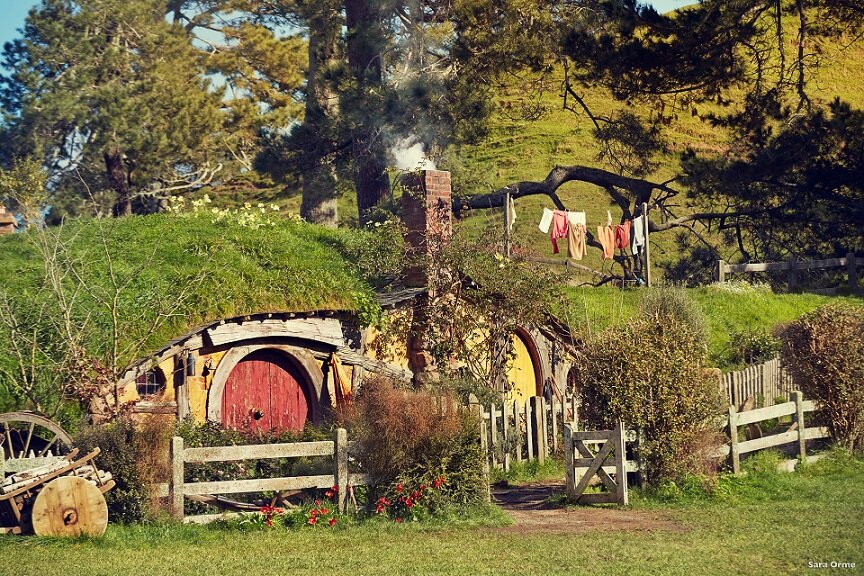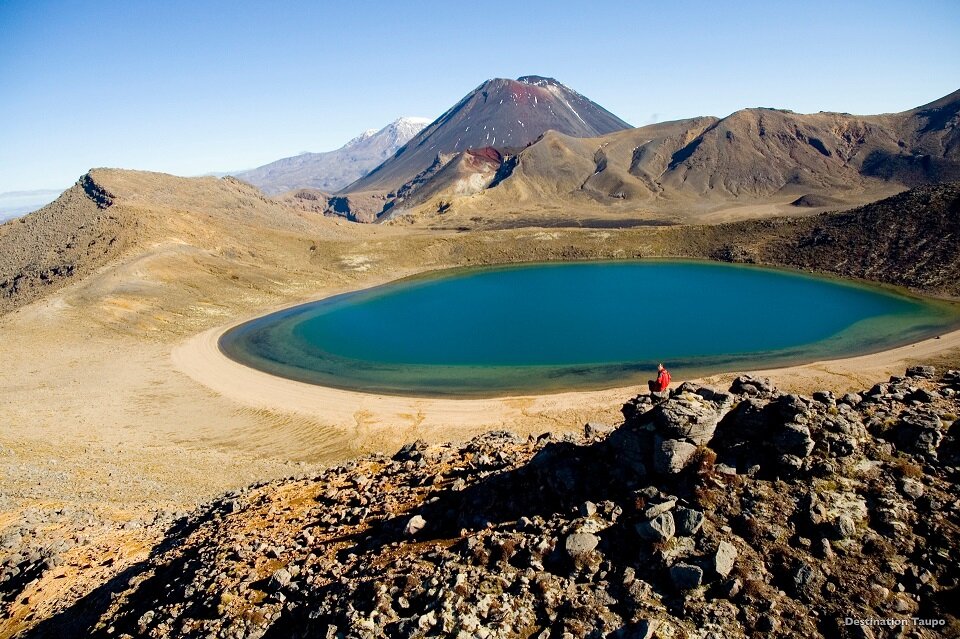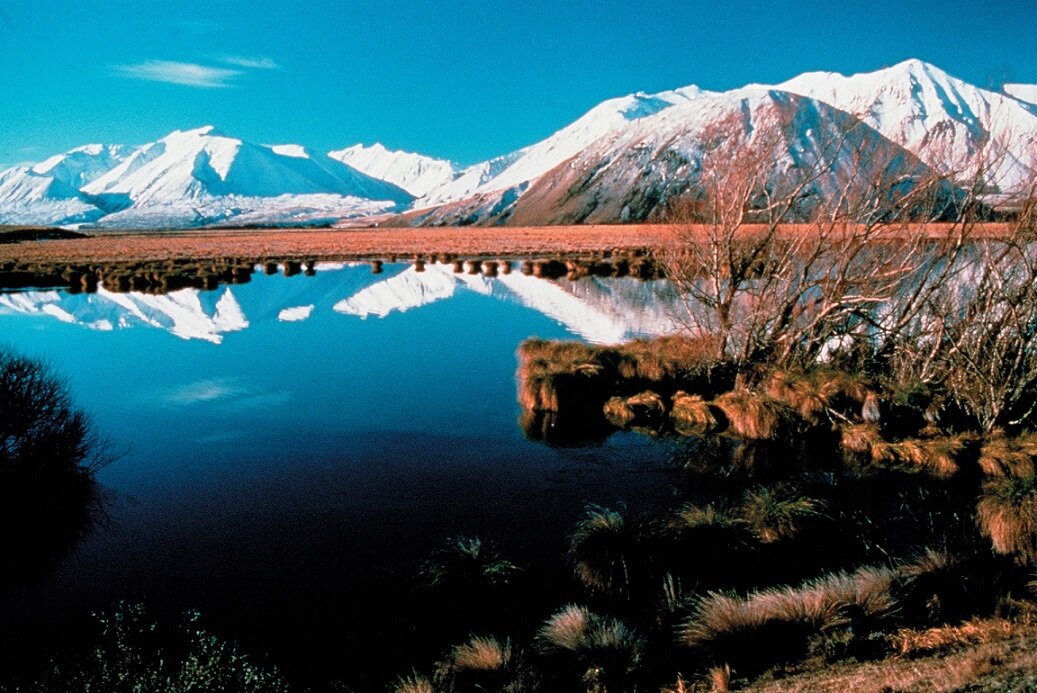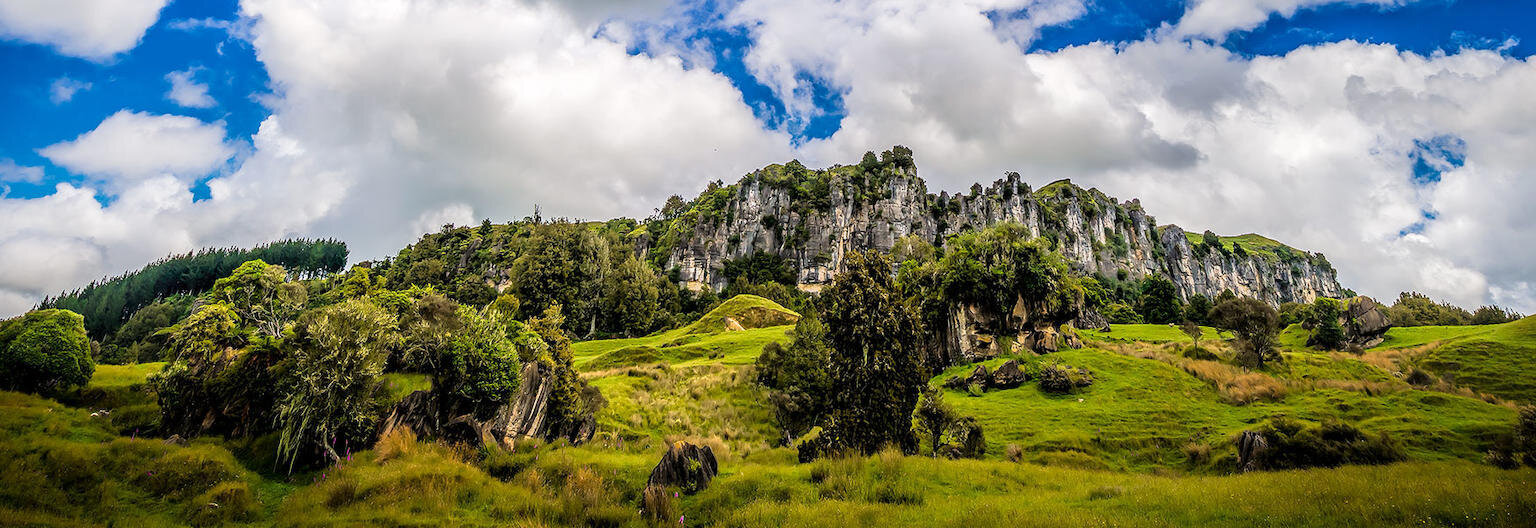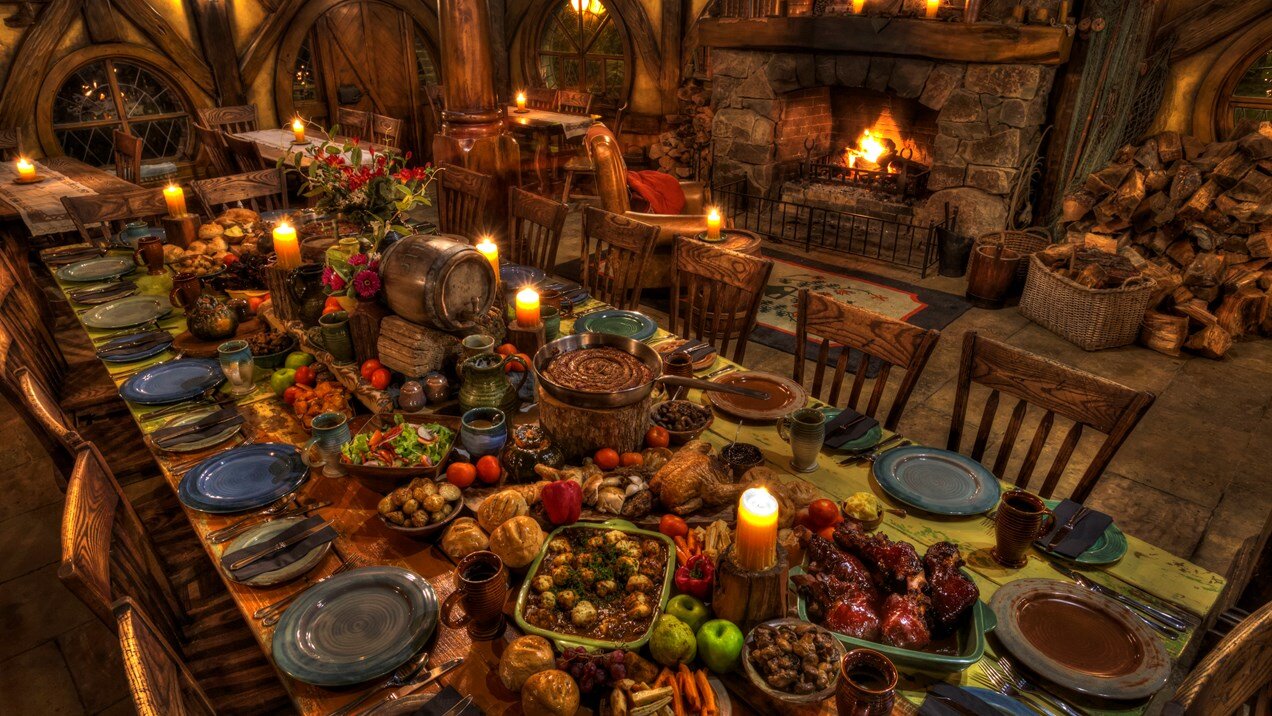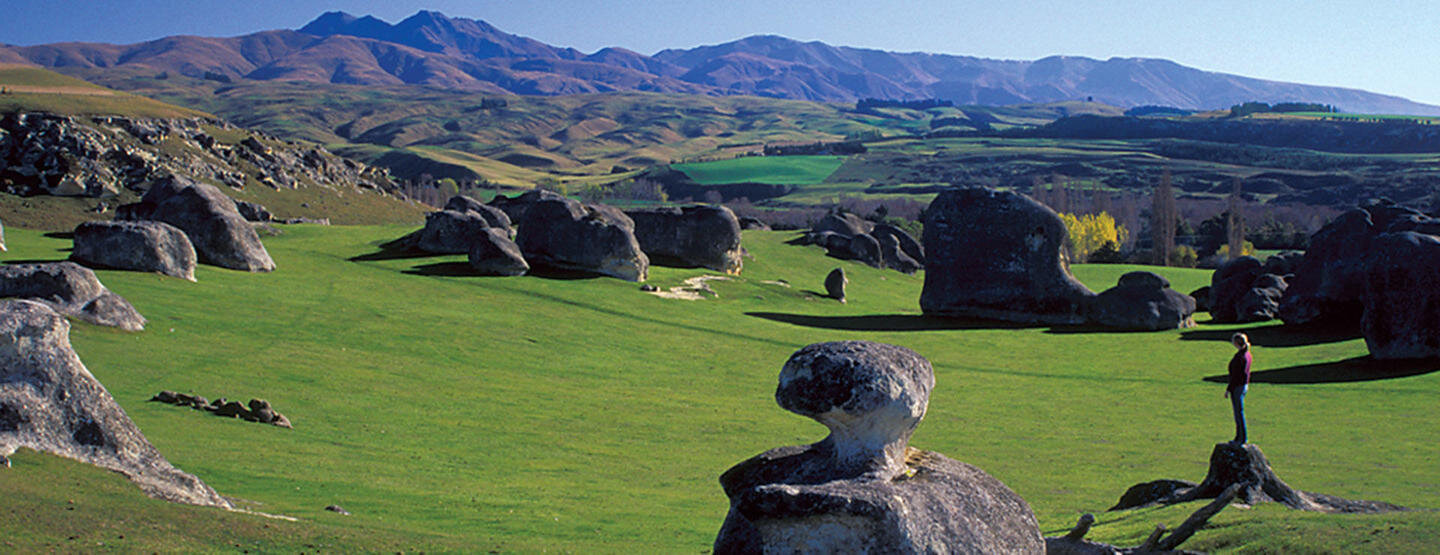Filming Locations
New Zealand is the best place in the world to be fully immersed in real movie locations, from The Lord of the Rings & The Hobbit trilogies, to The Chronicles of Narnia, King Kong and The Last Samurai.
Stand where the cast stood, partake in tourism activities where your favourite scenes were shot, and meet people who were involved in the movies themselves. The New Zealand film tourism experience is like no other.
THE LORD OF THE RINGS TRILOGY
The Lord of the Rings movie trilogy was filmed entirely in New Zealand. Experience the Lord of the Rings filming locations that starred as Middle‑earth™.
North Island Locations
Matamata
The Shire and Hobbiton Movie Set
The lush dairy farming landscape around the Waikato town of Matamata was used to portray the peaceful Shire region of Middle‑earth™. The village of Hobbiton was created here. It has since been rebuilt for the filming of The Hobbit Trilogy, and will now remain as a permanent attraction. See glorious 360-degree images of Hobbiton here.
Guided tours take you through a picturesque 1,250 acre sheep farm with spectacular views across to the Kaimai Ranges. Take a look at Bag End, where Frodo and Bilbo’s adventures began. Get lost among the hobbit holes and visit the Green Dragon Inn, the mill and the Party Tree. Listen to spell-binding tales of how Hobbiton came to be. Tours depart daily from the Shire's Rest Cafe in Matamata and from the Matamata & Rotorua i-SITEs.
Tongariro National Park
Mordor
Mordor, home to the Dark Lord Sauron was shot on location around the rocky slopes of the Tongariro National Park. The area’s jagged volcanic rock formations and eerie barren landscapes were ideal locations for creating Mordor’s hissing wasteland. As the centre piece of the films, Mount Ngauruhoe was digitally enhanced to create the fiery Mount Doom. Key scenes shot in the Ruapehu region also include the Emyn Muil (Iwikau Village at Whakapapa), Ithilien Camp (Mangawhero Falls) and Orc Army scenes (Rangipo Desert).
Wellington
Gardens of Isengard, the River Anduin, Rivendell, Osgiliath Wood, Paths of the Dead
The most accessible filming location in Wellington is Mount Victoria, which is within walking distance of the central city. The forested areas of the mountain were used to depict Hobbiton Woods, where the hobbits hid from the black riders.
Other Wellington locations include the Hutt River between Moonshine and Tōtara Park, which played the part of the River Anduin; and Harcourt Park, which was transformed into the Gardens of Isengard.
Wellington’s Kaitoke Regional Park became Rivendell, where Frodo recovered from the knife attack. The exact location - a grassy area surrounded by native forest - is signposted from the carpark.
From Wellington you can drive up the west coast to Queen Elizabeth Park near Paraparaumu, which was used for filming the Nazgul and mumakil in the Battle of the Pelennor Fields.
Further up the coast is Waitarere Forest (Osgiliath Wood), where Frodo, Sam and Gollum walked after leaving Faramir.
A drive over the hills to the Wairarapa region will take you to the eerie Putangirua Pinnacles, where Aragorn, Legolas and Gimli sought the Paths of the Dead.
Wellington is home to Weta Workshop, Weta Digital and the Miramar film empire which is central to The Hobbit Trilogy production. While the movie business centre is off-limits to visitors, The Lord of the Rings pilgrims can experience the Weta Cave.
South Island Locations
Nelson Tasman
Home of the 'One Ring', Chetwood Forest, Dimrill Dale
Nelson Tasman is home to Jens Hansen, the goldsmith responsible for creating the 40 different rings used in production. One of the original rings is on display and copies can be bought in 9 and 18ct gold.
From Nelson drive west over Takaka Hill, which was the filming site for Chetwood Forest. Here the Ranger 'Strider' led the hobbits into the rough country east of Bree in an attempt to escape the Black Riders.
You'll need to catch a helicopter to see where the fellowship hid from Saruman's black crows. Ask the pilot to show you Dimrill Dale - Mount Olympus and Mount Owen. From the air, you'll get an eagle's view of the region's three national parks - Abel Tasman, Nelson Lakes and Kahurangi.
Canterbury
Edoras
Nestled in the Ashburton District's high country sits Mount Sunday - a sheer-sided hill that was the set for Edoras, the main city of the Rohan people. Nothing remains of this set, which took nine months to build, however the location still has a powerful magic.
Mackenzie Country
Pelennor Fields
Near Twizel in the Mackenzie Country, Peter Jackson filmed the epic battle of the Pelennor Fields, where thousands of orcs bred by Sauron clashed with the men of Gondor and Rohan. The grassy fields that stretch to the foothills of the mountains look exactly as described in The Lord of the Rings Trilogy. The location is on private land, however you can arrange a tour in the town of Twizel.
Southern Lakes
Ford of Bruinen, Gandalf’s ride, Isengard and Lothlorien
From the village of Glenorchy, at the northern end of Lake Wakatipu, you can see the north-western slopes of Mount Earnslaw, which featured in the opening sequence of The Two Towers. From Glenorchy you can also discover Lothlorien - the beech forest on the road to Paradise.
Another memorable location can be found near Queenstown at Arrowtown where you can walk to the Ford of Bruinen on the Arrow River; you can also walk to Wilcox Green, where the Gladden Fields scenes were filmed.
From Chard Farm winery you can see a spectacular view of the Anduin and Argonath (Pillar of Kings). The Pillars were computer generated in the studio.
Drive over the Crown Range Road and you’ll find yourself in the Cardrona Valley. From here you can drive to the summit of the Crown Range for a panoramic view of Middle‑earth™. To the left are the River Anduin and the Pillars of the Argonath. In the hills straight ahead is the Dimrill Dale. In the distance is Amon Hen on the shore of Nen Hithoel.
Fiordland River
Anduin, Fangorn Forest
The Waiau River between Te Anau and Manapouri represented the River Anduin as the Fellowship paddled south from Lothlórien. The surrounding high peaks were used to depict the rough country south of Rivendell. To discover Fanghorn Forest, ask for directions to Takaro Road, which is near Te Anau. Both sides of the road were filmed as Fangorn Forest; remote cameras were strung from high wires to film Aragorn moving through the trees.
THE HOBBIT TRILOGY
The Hobbit Trilogy was filmed entirely in New Zealand, throughout locations in both the North and South Islands.
North Island Locations
Hobbiton
The rolling hills of The Shire were once again brought to life near Matamata, where Hobbiton was re-built for The Hobbit Trilogy. Also used in The Lord of the Rings Trilogy, Hobbiton has remained open as an attraction for Middle‑earth™ fans. Enjoy peering over a Hobbit’s front gate, dancing under the party tree or swigging back a beer at The Green Dragon Inn. Hobbiton Movie Set Tours - booking in advance is recommended.
Piopio
The looming cliffs, unusual limestone rock formations and prehistoric forest at Mangaotaki Rocks in Piopio looks as if it has been created especially to form the backdrop for Middle‑earth™. This area provided the location for Trollshaws Forest and Staddles Farm where a number of scenes from The Hobbit: An Unexpected Journey were shot; including The Company arriving at a destroyed farmhouse, the exit from the Troll Hoard Cave, Gandalf bestowing Sting upon Bilbo, Radagast's arrival and the Gundabad Wargs and Orcs attack. Experience the exact filming locations for yourself with Hairy Feet Waitomo Scenic Film Location Tours, where you'll join a guided tour and experience the movie making magic for yourself.
Turoa, Ruapehu
The rocky slopes and grassy tussock of Turoa in Ruapehu was the setting for Hidden Bay, the entrance to the Lonely Mountain in The Hobbit: The Desolation of Smaug. Turoa is a popular ski field on Mt Ruapehu in the Tongariro National Park. The area is also known for its breathtaking cycling and hiking trails, including The Tongariro Crossing which is considered one of the best one day walks in the world. Crew filmed here for one day, in which giant scaffolding was built down to the site in order to protect native flora and fauna on the mountain.
South Island Locations
Pelorus River, Marlborough
Peter Jackson chose the Pelorus River to film the dwarves in barrels scene that appears in The Hobbit: The Desolation of Smaug. Here, the dwarves were filmed floating in giant barrels down the river. Stephen Hunter, who played dwarf Bombur, called this experience 'his favourite day on set'. You can experience this exact location for yourself with an easy riverside walk, or take a guided kayak tour.
Twizel
Twizel's alpine magic was captured on-film in both The Hobbit:An Unexpected Journey and The Lord of the Rings Trilogy. Part of the Wargs chase was filmed here; and the largest battle scene ever - the Battle of the Pelennor Fields - was set in a remote Twizel field. Twizel is home to a charming mountain town, and a road trip around the local area will give you a feel for the spectacular scenes that were filmed here.
Queenstown
One of the most magical locations in The Hobbit: An Unexpected Journey; Earnslaw Burn is a glacier that has created a number of cascading waterfalls that tumble down a huge rock face. Here, Bilbo and The Company are filmed continuing on their quest after departing Rivendell. The Earnslaw Burn Track - beginning in Glenorchy - is a challenging full day hike that rewards with spectacular views at the head of the valley over the glacier and beyond. Passburn was used for the approach to Misty Mountains and Passburn Track on the Mavora Walkway - one section of New Zealand’s national walkway Te Araroa - is open to the public.
Fiordland National Park
Both The Hobbit and The Lord of the Rings Trilogies used the majestic Fiordland National Park for epic scenic shots. The scene where The Company flees the mountains on the backs of eagles in The Hobbit: An Unexpected Journey was filmed here also. Experience giant fiords and spectacular waterfalls with a helicopter flight or boat cruise. The grasslands of Te Anau Downs provided the backdrop for chase scenes, while Mararoa Saddle doubled as the wildlands which Thorin leads the dwarves through.
Lake Pukaki, Mount Cook
Stunning Lake Pukaki was chosen as the location for Laketown in The Hobbit: The Desolation of Smaug. Glacial lakes feed into Lake Pukaki giving the water its vibrant blue colour. The lake is also a favourite fishing, walking and cycling spot, while the snowcapped Mt Cook overlooking the lake is busy with skiers during the winter months. Braemar Station at Lake Pukaki was used in The Hobbit: An Unexpected Journey to portray epic scenic shots, the 'Warg Chase' and approach to Rivendell. The property was also used for the forest slopes of Misty Mountains.
THE CHRONICLES OF NARNIA
Visit some of the most stunning New Zealand locations from 2005's The Lion, the Witch and the Wardrobe and 2008's Prince Caspian.
Cathedral Cove - Cair Paravel ruins
The Coromandel Peninsula - which lies east of Auckland and across the Hauraki Gulf - served as the settings for scenes in which the Pevensie children took their first steps back into Narnia. Cathedral Cove, on the eastern shore of the peninsula, is where the siblings discover the ruins of Cair Paravel, defined by a deep river chasm book-ended by cascading waterfalls that plunge 200 feet into the glassy waters. The Coromandel region sits on a narrow stretch of pohutukawa-lined coves, white sand beaches and lush rainforested hills, and offers a blend of nature and recreation experiences - lazy summer holidays, water sports, walking tracks, gold mining and logging history, and a thriving artistic community. Seafood is a speciality of the Coromandel region where oysters, mussels, scallops and other foods are grown and harvested sustainably offshore.
Flock Hill - The Great Battle
High in the Southern Alps of the South Island is an area of tortured rocks and dramatic valleys known as Flock Hill. It was here that director Adamson created the scenes for the great battle for Narnia. Flock Hill is 90 minutes from Christchurch on the Arthur's Pass Highway to Greymouth. Leaving Christchurch, the South Island's largest city, the road crosses the flat expanse of the Canterbury Plains through the small towns of Darfield and Sheffield.
Elephant Rocks - Aslan's Camp
The ancient Elephant Rocks that sprout from the rolling hills in the Waitaki district of the South Island were transformed into Aslan's Camp. Elephant Rocks are situated near Duntroon, a 40-minute drive from Oamaru on State Highway 83.
Millions of years ago this whole area was under the sea. Whales and other marine life sank into the soft sand which then gradually rose to the surface. The result is an intriguing area of fossils and dramatic limestone outcrops. Vanished World visitor centre in Duntroon houses interpretive displays on the area’s geological past.
The historic town of Oamaru - where white limestone Victorian buildings stand as a reminder of times gone by - is the ideal base for exploring the area. Originally built as warehouses and storage areas for the nearby port, the Harbour / Tyne area is home to antique shops, gift stores, craftsmen and restaurants.
Close by is the Oamaru blue penguin colony. The smallest of their kind in the world, the blue penguins nest beside Oamaru Harbour and can be viewed in their natural habitat. Oamaru is also home to the award-winning Whitestone Cheese, and the factory has an onsite café and shop allowing visitors to sample local produce and wine.
KING KONG
New Zealand was showcased on the big screen by Peter Jackson in the blockbuster film, King Kong.
Shelly Bay and Lyall Bay - Skull Island
Filming for Skull Island took place at Lyall Bay. A second large-scale version, including the giant wall which separated Kong from the rest of the island, was built above the Massey Memorial near Shelly Bay. Skull Island was a key location in the original 1933 movie, and Jackson''s film follows the 1933 version faithfully, with a large portion of the film set on ''the island''.
THE LAST SAMURAI
The seaside city of Taranaki is famous for being able to travel from the mountain to surf in just one day, and it was exactly that which drew The Last Samurai to the region to film in its diverse locations.
Uruti Valley – Japanese village
Much of the filming centered on the hillsides of the Uruti Valley, which was remodelled slightly to imitate Japanese rural life in the 1860s. Mount Taranaki, New Zealand’s most-climbed mountain, turned on a stunning performance as Mount Fujiyama.
THE WORLD’S FASTEST INDIAN
Southland’s main centre, Invercargill, played host to the film crew of The World's Fastest Indian during the New Zealand portion of the film.
A key location for the New Zealand shoot was beautiful Oreti Beach, which was used for Munro’s beach racing scenes. The street where the Post Office was set is called The Crescent, and had 1960s phone booths and parking meters fitted especially for the shoot.
For those visiting the Invercargill, many of Burt Munro’s tools and props from his toolshed are on display in a local hardware store. Sir Anthony Hopkins borrowed these during filming to add to his character’s authenticity.

